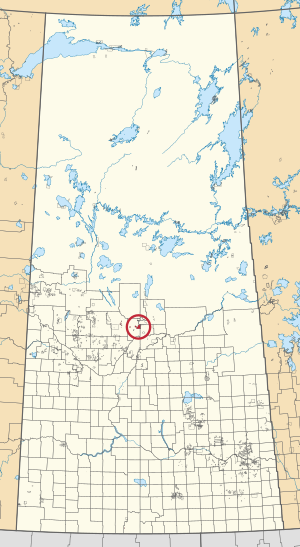Sturgeon Lake 101 facts for kids
Quick facts for kids
Sturgeon Lake 101
|
|
|---|---|
| Sturgeon Lake Indian Reserve No. 101 | |

Location in Saskatchewan
|
|
| First Nation | Sturgeon Lake |
| Country | Canada |
| Province | Saskatchewan |
| Area | |
| • Total | 8,889 ha (21,965 acre) |
| Population
(2016)
|
|
| • Total | 1,174 |
| Community Well-Being Index | 43 |
Sturgeon Lake 101 is a special area of land in Saskatchewan, Canada. It is known as an Indian reserve, which is land set aside for a specific First Nation group. This reserve belongs to the Sturgeon Lake First Nation.
Sturgeon Lake 101 is located about 29 kilometers northwest of Prince Albert. In 2016, a count showed that 1174 people lived there. They lived in 287 homes out of 293 total homes on the reserve.
Contents
About Sturgeon Lake 101
Sturgeon Lake 101 is one of the lands that belong to the Sturgeon Lake First Nation. These lands are important for the community's culture and way of life.
What is an Indian Reserve?
An Indian reserve is a piece of land in Canada that the government has set aside for the use and benefit of a First Nation group. These lands are protected and managed by the First Nation themselves. They are not like regular towns or cities.
Who are First Nations?
First Nations are the original people who lived in Canada before European settlers arrived. They have rich histories, cultures, and languages. Each First Nation is a unique community with its own traditions.
Where is Sturgeon Lake 101 Located?
Sturgeon Lake 101 is found in the Canadian province of Saskatchewan. It is in the central part of the province, not too far from the city of Prince Albert. This location is important for the community's connection to its traditional lands.
How Many People Live There?
According to the 2016 Canadian Census, 1174 people lived on Sturgeon Lake 101. They lived in 287 homes. This information helps us understand the size of the community.
What is the Community Well-Being Index?
The Community Well-Being Index (CWB) is a way to measure how well a community is doing. It looks at things like education, jobs, income, and housing. The index is scored out of 100.
In 2016, Sturgeon Lake 101 had a CWB score of 43. This was lower than the average for other First Nations communities (58.4). It was also lower than the average for non-Indigenous communities (77.5). This score helps show areas where the community might need more support.

